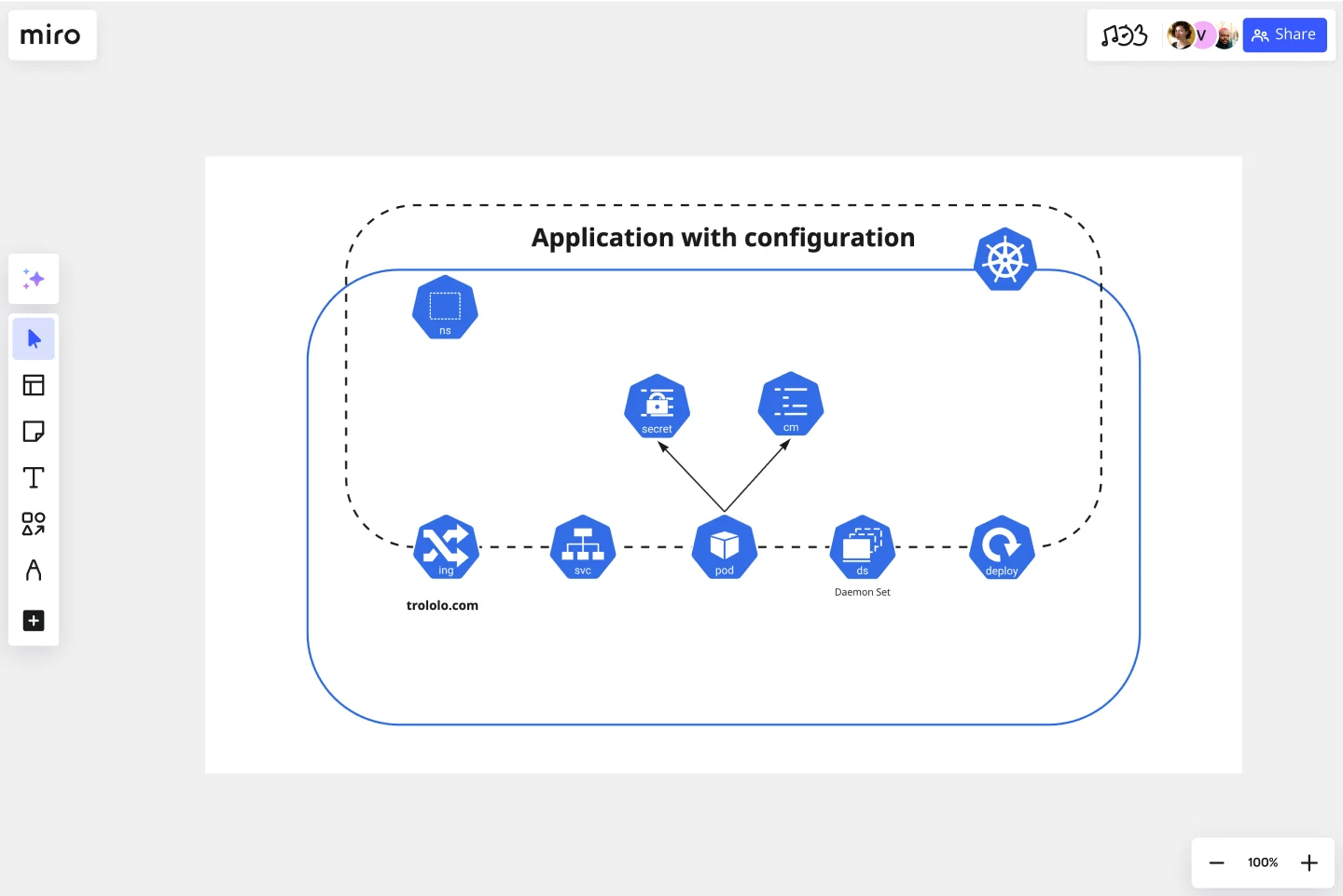Kubernetes Application Template
Visualize the deployment of enterprise applications with this Kubernetes Application template and optimize your processes.
Available on Enterprise, Business, Education plans.
About the Kubernetes Application Template
The Kubernetes Application allows you to manage enterprise-ready containerized apps. It shows prebuilt deployment templates, portability, and simplified licensing and consolidated billing.
Keep reading to learn more about the Kubernetes Application Template.
Why use a Kubernetes configuration management
You can use a Kubernetes Application to run deployments anywhere, in Anthos, the Cloud, or Kubernetes clusters in other environments.
Developers use containers because they provide extra benefits such as agile app creation and deployment, and are set up for continuous development and integration. Kubernetes image immutability allows for quick and efficient rollbacks, making containers easy to operate. Kubernetes Applications also feature prebuilt deployment templates and default configurations.
How do I create a Kubernetes Application template?
A Kubernetes Application template allows you to visualize the deployment enterprise containerized of apps.
To create a basic Kubernetes Application template with Miro, you can follow these steps:
Define your Kubernetes Application cluster.
Use our set of Kubernetes Icons to place each component.
Organize your diagram by adding connection lines between the component shapes
Use arrows to indicate the flow of information and format your Kubernetes Application template.
In Miro, you can quickly build a Kubernetes Application from scratch using our design tools and icons set, or use our Kubernetes Application template and customize it as you see fit.
Which Applications are managed by Kubernetes?
Here are some of the applications managed by Kubernetes: GitLab, CloudBees, Neo4j, Seldon, Aerospike, Couchbase, WordPress, Prometheus, among others. With Miro, you can use a Kubernetes Application template to diagram your cloud architecture and better manage your applications. Try it out and see how it can work for you.
Get started with this template right now. Available on Enterprise, Business, Education plans.
Cloudflare RAG Architecture Knowledge Seeding Template
The Cloudflare RAG Architecture Knowledge Seeding template in Miro streamlines the sharing and visualization of cloud architecture knowledge, making it ideal for tasks like cloud infrastructure optimization and diagram creation. This template enables straightforward documentation and collaboration, ensuring complex information is accessible to all team members.
Cloudflare RAG Architecture Knowledge Queries Template
The Cloudflare RAG Architecture Knowledge Queries template is a cutting-edge tool designed to streamline the process of diagramming and understanding the intricate architecture of Cloudflare's Retrieval Augmented Generation (RAG) system. This template is a boon for teams aiming to visualize, query, and optimize Cloudflare's infrastructure collaboratively.
Stakeholder Mapping Template
Works best for:
Business Management, Mapping, Workflows
A stakeholder map is a type of analysis that allows you to group people by their power and interest. Use this template to organize all of the people who have an interest in your product, project, or idea in a single visual space. This allows you to easily see who can influence your project, and how each person is related to the other. Widely used in project management, stakeholder mapping is typically performed at the beginning of a project. Doing stakeholder mapping early on will help prevent miscommunication, ensure all groups are aligned on the objectives and set expectations about outcomes and results.
Flyer Maker Template
Works best for:
Design, Marketing
Whether it’s a client party or a nonprofit fundraiser, your event needs one key thing to be a smashing success: people to show up. That’s why promoting it is such an important part of the planning—and creating and sending a flyer is the first step. These single-page files will grab your guests’ attention and give them the key details, such as the time, date, and location (and if it’s a fundraiser, who/what the funds will benefit). This template will let you lay out text and customize a flyer design.
UML State Machine Diagram Template
Works best for:
Software Development, Mapping, Diagrams
Visualize the workflow of a process and how objects perform actions based on different stimuli. State machine diagrams are valuable for understanding how an object responds to events at the different stages of its life cycle. They are also helpful for visualizing event sequences in a system.
ERD Blogging System Template
Works best for:
ERD
The ERD Blogging System template in Miro efficiently manages and organizes digital content. It features key entities such as User, Post, Comment, Category, Tag, and File, which are essential for managing the creation and publication of blog posts, engaging users through comments, and organizing content via categories and tags. Additionally, it supports media attachments through the File entity, linking them to the relevant content. This template helps streamline the blogging process, making it an invaluable tool for content management and publication.
